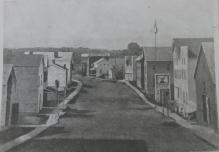

Left click on the image below for a larger version.

Left click on the image below.
Grand Rapids in about 1960 and before.

Some items below are from the RootsWeb.com project. All over the country genealogical information from many sources - books, newspapers, tombstones - is being transcribed and made available online. This is one example of the kind of information available, and is in turn taken from a book published in 1900, when Augustine Godwin was still alive - he died in 1909.
Left click on the images below for larger versions.
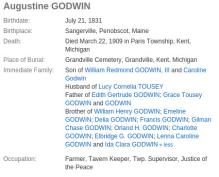
Augustine Godwin - 2014 information. |
The toll stop referred to below was at the location of Division Avenue and Allen Road (now 36th Street), but on just which corner is unclear. It seems possible that it predated the construction of Frank Rackett's house, which later replaced the struture. This is at least plausible. The Grand Rapids and Indiana Railroad was completed to Grand Rapids in 1870. The toll road instantly became unnecessary. A plank road, providing a miserable ride, people would likey have switched to the railroad to go to and from Kalamazoo almost immediately. In the same general area there was a "tavern" (apparently what travel lodges were then called), built in 1865 according to the reference above. The Tavern burned down in 1871. Being too far from the Grand Rapids and Indiana Railroad tracks, and with no evidence that there was ever a stop or depot near 36th Street - the tracks cut through a rather large swamp at the time - there was no good reason to rebuild the Godwin tavern. So it's quite possible that the toll stop was located on the northwest corner of 36th and Division, and was later replaced by Frank Rackett's house, perhaps some time after 1876.
See section "R" for some details about Frank Rackett, and how he happened to locate on the location of the former toll road collection stop.
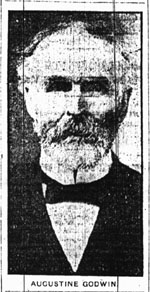
Augustine Godwin, from a 1909 obituary notice.
Augustine GODWIN of Wyoming Township, Kent County, Michigan
From Bowen, A.W., The City of Grand Rapids and Kent County, published 1900, page 713.
Left click on the images below for larger versions.

|
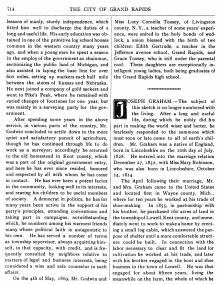
|
Left click on the images below for larger versions.
Left click on the image below for a larger version.
Augustine Godwin death certificate, dated March 22, 1909.
Left click on the images below for larger versions.

Augustine |
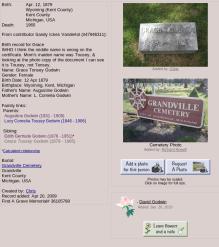
Grace |

Edith. |

Death Was Sudden Augustine Godwin, Pioneer, Dies on Farm on Which Parents Settled 75 Years Ago
The oft-expressed desire of Augustine Godwin for a sudden death was realized yesterday morning at his farm, known as the Godwin place, one and three-fourths miles south of Burton avenue on the Division street road, when he expired suddenly from what the hastily physicians pronounced a congestive chill.
Mr. Godwin, whose age was 78 years, was born in Sangerville, Me., but came to Michigan with his parents when he was but 3 years old. The family settled on the farm on which he died, and on which he resided ever since until five years ago, when he moved his family of two daughters to the city residence at 542 Jefferson avenue, in which they now live.
Mr. Godwin was a particularly rugged man for one of his years, and yesterday morning walked from his city home to his farm with a couple of prospective tenants. It is thought that his exertions on the trip brought on the attack, about 11 o'clock, to which he succumbed two hours later.
Mr. Godwin was the last surviving male member of a family of seven brothers. He had long been enthusiastic in the political affairs of his community, and for many years held the office of supervisor of Wyoming township. He is survived by two daughters, Edith and Grace, who live at the home on Jefferson avenue; also four sisters, Mrs. William Dunham, 281 Cherry Street; Mrs. D.W.C. Blackmer, 481 South College Avenue; Mrs. Arthur Meigs, Jacksonville, Fla.; Mrs. William Couch, Sebastopol, Ca.
Funeral services will be held from the residence tomorrow afternoon. Interment will be in Grandville cemetery.
(Material provide by Jennifer Godwin.)

Augustine Godwin died in 1909, and what became of the property is mildly mysterious. Frank Rackett owned some part of it. Whether his house, on the corner of 36th Street, was some kind of toll road caretaker's house, or part of the Godwin estate is somewhat unclear. Does anyone have photographs of any parts of the Godwin farm?
The following photograph is a good example of the perils of undocumented
photographs. There are vast collections of old photographs around the
country with stunning photos of people about which absolutely nothing is
known. No dates, names, or places. For most purposes they are worthless.
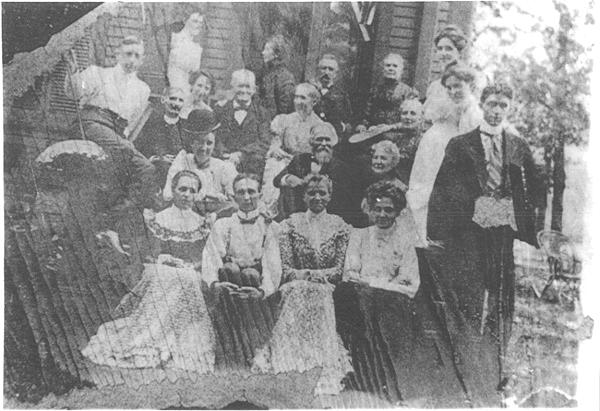

The following fragment covers the earliest period of the Godwin school
system, and at present ends just about the time the school was moving
to what was then considered a more central location.
GODWIN - WYOMING - BYRON HISTORY
A history of the Godwin School District involves a close look at the pioneer days of Wyoming and Paris Townships. Both townships were out-growths of the settlement at Grandville. Indeed, the settlement at Grandville was the first real settlement in the Grand River Valley. In 1832 Louis Campau had a trading station at Grand Rapids and Rix Robinson was involved in the Ada area; however, they cannot be considered as occupants and settlers at this time because they had no rights other than a license to trade and they were completely dependent on the Indians for any further right. The first farms in the Grand River Valley were to be found in Wyoming and the first crops were raised there. The earliest land owners were ROBERT HOWLETT, LUTHER LINCOLN, AMOS GORDON and STEPHEN TUCKER. Luther Lincoln was the first of these men to plant crops. He wrote a letter in 1833 which is very descriptive of the area.
Grand River, 4th mo. 22nd, 1833
Dear Father and Mother,
I tak this opportunity to inform you that I and children are well and hope you are all enjoying the same Blessing. I received a letter from you 2 weeks ago asking some questions Respecting the country and other affairs which I expect are Sufficiently answered in my last letter.
If you want to know town and county that I live in a town without inhabitance without name in the county of Kent 6 miles below the rapids on the United States road from Datroit to the mouth of the river laid last Faul.
I have been up the grand River to get my flour and potatoes 60 miles on the big fork 25 miles from Gull Prairiey. It runs through an excellent country of timber on one side with many rapids which was hard to acend with an empty boat but we went down quick. Struck a few times on the rocks. We went down 30 mile in half a day. A grate mill Stream; a grate Spring Brook; 6 rood wide. Here the land is for Sale a man can have his choice.
It has jest come into the office. Where I am there is a prareia good timber land good opening good pine some good grass. I have 2 lots a piece of medow the best I ever saw. It is dry enough. This country will Settle and must. I have ben to see my cattle in an all 28. they look well.
1
There coats are about half off. In about 1 week I shall put 5 yoak on 1 Plow and Plow as long as it will do to Plant. It has ben a moderate open winter and open. It is begun to be warm. My hogs I have not herd of for 1 month till today. I see an Indian looking after horses. He said they near the head of a certain creek.
(Signed) Luther Lincoln
Other early settlers were GEORGE THOMPSON, HIRAMAND LUMAN JENISON and E.T WALKER. Still another Grand Valley Pioneer, WILLIAM R. GODWIN, settled in 1834. It is said that at this time it took ten days to travel from Ann Arbor to Grandville, the mosquitoes were numerous and blood-thirsty, and the curse and terror of the pioneers was the ague.
According to descriptions of the land, the low lands along Buck Creek were of the rich black loam variety and were therefore exceptionally fertile as corn and grain land. The higher land was strong fertile clay soil which also yielded abundant crops if properly cultivated. The entire county also had the advantage of the many springs and creeks and therefore had land especially good for grazing purposes. The county became extensively engaged in the stock business.
The first wedding in the Grand River Valley took place in Wyoming Township. SYLVESTER HILLS married HARRIET BURTON in the winter of 1835-36.
Life in the wilderness was never easy. The winter of 1836-37 was a particularly had winter for the valley. There was little to eat and what there was, beside sturgeon from the river, had to be packed in from the southern part of the state. Flour was being sold for 10 cents a pound and many people ate flour that had been sunk in the river. Pork was being sold for 18-3/4 cents a pound and beans were $6.00 a bushel. Still the people were happy and didn't complain of suffering. FRANKLIN EVERETT, a Grand River Historian, comments that the absence of complaints from the early pioneers show how little happiness depends on fortune.
On May 2, 1836 the first township in Kent County was organized at the home of CHARLES H. OAKES in Grandville, Michigan. The district was compiled of townships five and six north, or ranges twelve and thirteen west. Most all of South Kent territory was included in this original township and it was called Byron Township. The following were the first officers chosen for this township.
Supervisor Gideon H. Gordon
Clerk Isaac A. Allen
Assessors Eli Yeamon, Ephrain P. Walker, Justin Brooks
Justices G. H. Gordon, Robert Howlett, E. P. Walker
Collector L. French
Commissioners of Hwys Jos. B. Coperland, S. Buskirk, James Lockwood
School Inspectors G. H. Gordon, Isaac A. Allen, Eli Yeamons
Overseers of the Poor E. P. Walker, Justin Brooks
Constable L. French
2
The township of Wyoming was organized out of the original Byron Township by an act of the state legislature approved on March 9, 1848 with the boundaries being all of town 6 north, range 12 west, Byron being set off as a separate township.
At a meeting at the house of DWIGHT RANKING the following officers were chosen.
Supervisor Wm. H. Godwin Clerk Joseph Blake Treasurer Chase Edgerly Justices E. Yeoman, Roswell Britton Commissioners of Hwys. Nicholas Shoemaker, Dwight Rankin, James P. Jewell School Inspectors Luther D. Abbott, Justice C. Rogers Overseers of the Poor William Richardson, J. A. Britton, C. J. Rogers Constable H. N. Roberts
Because of the growth of Grand Rapids, three and one-half sections of the original Wyoming Townships were soon transferred to the city of Grand Rapids, and the portion of the township which was north of Grand River was attached to Walker township so that around 1900 the township of Wyoming contained only about twenty-eight sections of land. Today it is somewhat smaller yet due to more recent annexations.
Wyoming is bounded on the north and northwest by the city of Grand Rapids and the township of Walker, on the east by Paris, on the south by Byron and on the west by Ottawa County.
Paris Township is the second oldest township in the area in point of settlement. In 1833 five Grand Valley Pioneers located in this township. These five men were BARNEY BURTON, EDWARD GUILD, JOEL GUILD, DANIEL GUILD, and JAMES VANDERPOOL. Other early settlers included BENJAMIN CLARK and ABRAM LARAWAY, in 1835; JACOB PATTERSON, MINER PATTERSON, JAMES PATTERSON, ORLEAN SPAULDING and PHILANZO BOWEN, 1836; NICHOLAS CARLTON, 1837; and HIRAM H. ALLEN in the year 1838.
The first log house and the first barn were erected by Mr. Burton. The first frame house in the area was also erected by MR. BURTON and it was located in the area known as Garfield Park.
The soil of the southeastern and central parts of the county was sandy and good for fine crops of grain and vegetables. Like Wyoming, Paris was also a stock raising county.
3
In 1838 there was one main thoroughfare in the township. This was the Gull Prairie Road or the Kalamazoo Road. It is now known as Division Avenue. A journey between Grand Rapids and Kalamazoo on this road took two days. Nearly all travelers from the east approached Grand Rapids by this road. In 1854 the road was made into a plank road. W.H. WHITEY was the proprietor of the first line of stages on the new road. JAMES SCRIBNER’S two daughters were the first two ladies to pass over the plank road between the two cities. The planks enabled the travelers to make the trip in one day.
Until the completion of the Detroit Milwaukee Railroad in 1858 the road was of great importance to the growth of Grand Rapids. As many as 170 (?) teams would come into the area over this road in one day. Many of these teams brought loads of corn and pork for the Grand Rapids market which in turn would furnish large amounts of these staples to lumbermen in this vicinity and farther north.
Taverns were built all along the road to accommodate the travelers and also to rest or change horses. One of the best known ones was at Kelloggsville. another one was the Godwin House or Hotel which was built in 1865. There were toll-gates too, and anyone driving on the road had to pay a toll. There was a toll-gate on the corner of 36th and Division where the Godwin Schools Administration Building now stands. The usual charge for using a toll road was ten cents for a team and five cents for a one horse rig. The keeper could be awakened any time, day or night, to raise the gate and collect the toll. With the completion of the Grand Rapids and Indiana (later Pennsylvania) Railway in 1869 the stage coaches ceased to be used at all, so the toll-gates were abandoned and later moved away.
When the pioneers first settled the county there were no regular Indian camp sites although Indians would occasionally pitch tents for a few days while out hunting and fishing. A regular colony was formed, how-ever, around 1840 near section 33, 52nd Street East of Kalamazoo. The Indians lived here for several years, but they sold their lands and left as the county became more thoroughly settled.
Indicative of the rate of growth of the county are these two population figures. In 1860 there were 1,314 people living in Paris County and in 1870 there were 1,534. this shows a gain of only 220 residents in a ten year period.
In 1839 the Michigan State legislature created the township of Paris. The original township included Gaines Township. The first town meeting was held at the house of HIRAM H. ALLEN. The first township officers elected were: Supervisor Joel Guild
Clerk Hiram H. Allen
Treasurer Robert Barr
Assessors Stephen Hinsdill, Forest Kelley, Joseph H. Blain
Justice’s of the Peace H.H. Allen, Hezekiah B. Smith, Barney Burton, Alexander Clark
Commissioners of Hwys Joseph Blain, Jacob Patterson, John Kirkland
4
Collectors Andrew Mesnar, Daniel Guild
Constables Jacob Patterson, Joseph J. Baxter, Palmer Allen
The township of Paris as it now stands is situated in the second tier of townships from the south line of the county and is bounded on the north by Grand Rapids, on the east by Cascade, on the south by Gaines, and on the west by Wyoming.
The pioneer people responsible for developing schools in our area are well worth our consideration at this point.
Godwin Public Schools are named for AUGUSTINE GODWIN son of WILLIAM R. GODWIN, who was previously mentioned for being one of the original Grand Valley Pioneers and the first supervisor of Wyoming Township. Mr. William R. Godwin and his wife, CAROLINE HARLOW GODWIN, came to Grandville from Gardiner, Maine in 1833. Mr. Godwin’s original purpose in coming to this area was to establish and Indian trading post in partnership with a MR. FERRY. They had some bad luck upon their arrival, however, when the goods they had brought for establishing their business burned with the house in which they were stored. Being a true pioneer Mr. Godwin did not let this unfortunate occurrence get him down although it did serve effectively to change his plans. He purchased land from the government which was located about two miles south of Grand Rapids in Wyoming Township. Mr. Godwin prospered as an agriculturist. After clearing and improving his original purchase, he added more land. At the time of his death in 1861 he possessed a beautiful farm of 120 acres in addition to properties of various kinds. His farm was located on section 13 in Wyoming Township.
For several years William R. Godwin was the proprietor of the Godwin House or Hotel previously mentioned in connection with the old plank road to Kalamazoo. Mr. Godwin had assisted in the construction with the plank road as a contractor. The Godwin House was a favorite resort of the traveling public in pioneer times. A.W. BOWEN give the following information about Mr. Wm. Godwin in The City of Grand Rapids and Kent County Michigan Up to Date, (1900).
He continued to accommodate such travelers as saw fit to patronize his house as long as he lived, and earned the reputation of a most popular and genial host. His name was widely and favorably known throughout a large area of territory traversed by tourists and others. --- Politically he was an old-line democrat, active in the councils of his party and leading spirit in all public enterprises.
5
He did much to advance the material well-being of the community he had assisted in founding, and to him as much as to any other man is due the prosperity with which this section of the country has since attained.”
The William R. Godwins’ had eleven children. WILLIAM HENRY went to Kansas and served there and in various other Western states as a United States surveyor. EMELINE married WILLIAM DUNHAM of Grand Rapids. DELIA married D.D. BLACKBURN of Grand Rapids. FRANCIS died in Missouri at the age of twenty-five. GILMAN CHASE was a member of the Kent County Bar, held many elected and appointed offices and was one of the founders of the law firm of GODWIN, ADSITO and MC KNIGHT of Grand Rapids.
ORLAND served as Kent County clerk until his death. CHARLOTTE married ARTHUR MIEGS, a lumberman at Jacksonville, Florida. LENNIE CAROLINE died at fourteen. ELDRIDGE and IDA both remained in Grand Rapids until their deaths. AUGUSTINE GODWIN, the second oldest of the children, lived for many years on the family homestead and was the person for whom our school district is named.
Augustine Godwin was born in Maine July 21, 1831. In 1834 he came to Kent County in an ox cart to join his parents who had made the journey the previous year. Mr. Bowen gives the following account of the life of Augustine Godwin.
The best title one can establish to the high esteem of an intelligent community is a long and honorable residence therein. Such a title clearly belongs to Augustine Godwin, who for a period of over sixty-five years has been an honored citizen of Kent County and one of the architects of its fortunes. He grew to manhood amid the stirring scenes of the early time; and, when of proper age, he became his father’s assistant on the farm, where he learned those lessons of manly, sturdy independence, which fitted him well to discharge the duties of a long and useful life. His early education was obtained in one of the primitive log school houses common in the western country many years ago, and when a young man he spent a season in the employ of the government as a chainman, sectioning the public land of Michigan, and also assisted in laying the base line for over 600 miles, setting up markers each half mile between the states of Kansas and Nebraska. He next joined a company of gold seekers and went to Pikes Peak, where he remained with varied changes of fortune for one year, but was mainly in a surveying party for the government.
After spending some years in the above service, in various parts of the country, Mr. Godwin concluded to settle down to the more quiet and satisfactory pursuit of agriculture though he has continued through life to do work as a surveyor; accordingly he returned to the old homestead in Kent county, which was a part of the original government entry, and here he has resided ever since, honored and respected by all with whom he has come into contact.
6
He has ever been a potent factor in the community, looking well to its interests and rearing his children to be useful members of society.
A democrat in politics, he has for many years been active in the support of his party’s principles, attending conventions and taking part in campaigns; notwithstanding which, he numbers among his warmest friends many whose political faith is antagonistic to his own. He has served for a number of terms as county supervisor, always acquitting himself, in the capacity, with credit, and is frequently consulted by neighbors relative to matters of legal and business interests, being considered a wise and safe counselor in such affairs.
On the 4th day of May, 1869, Mr. Godwin and MISS LUCY CORNELIA TOUSEY, of Livingston County, New York, a teacher of some years’ experience, were united in the holy bonds of wedlock, a union blessed with the birth of two children; EDITH GERTRUDE, a teacher in the Jefferson avenue school, Grand Rapids and GRACE TOUSEY, who is till under the parental roof. These daughters are exceptionally intelligent young ladies, both being graduates of Grand Rapids high school.”
JOHN WESLEY PENNELL was another pioneer active in the affairs of the school district. He owned and operated a large dairy farm, the homestead being located on the lot later occupied by the DR. GAINEY home. He owned land on both sides of Division Avenue, and his memory is perpetuated by the name given to the road leading to the old Grand Rapids airport. Incidentally, his oldest daughter, HATTIE PENNELL, later MRS. WEATHERWAX, was a teacher in the old white school house now replaced and called Town Line school.
RILEY COLE was one of the first school officers, and he owned land on the northeast corner of Freedom Street.
Another man very active in the district was JOHN HUGHES. His home was located where the old Herzog Inn later stood on the corner of Conrad and Division.
WRIGHT C. ALLEN for whom ALLEN ROAD, now 36th Street, was named was director of the district for a term and later treasurer. His home stood on 36th Street East, at the southwest corner where Michigan Central tracks cross the street
The first school house which served the communities now served by Rogers School and Godwin Schools was built on the southeast corner of section 14 in Wyoming Township which is the corner of Clyde Park and 36th Street. As nearly as can be learned this was opened in the year 1843. It was located on land owned by JACOB ROGERS who was deeded a quarter section by the United States government in 1837. The first teacher was ROZANNA SHAFER.
The school house was built by MR. POTTER and may be described as a long, low, one room building made of rough boards just as they came from the saw mill. The only boards that were planed were those in the desk, the seats, and the window casings. And if, in imagination, we were to look inside, we would no doubt find the traditional straight backed benches for seats and a large oblong box-like stove with a circular drum above it to radiate more heat.
7
And if it should be a cold winter morning, we would see a circle of pupils standing around the stove getting warm; for the corners away from the stove are not warm enough to be comfortable. Shelves have been placed on the front walls on either side of the entrance for the pupils’ dinner-pails and pegs are along the side for coats and caps.
Let us look in one corner near the door. On a stool, or more likely a block of wood, will be the proverbial water-pail with a dipper in it, and sometime during the session, some boy or girl will ask permission to “pass the water” - a coveted privilege. The water has probably been carried from the nearest house, perhaps a quarter of a mile away.
The boards of the floor are knotty and rough. The following is a true story about the rough floor. CHARLES ROGERS, son of JACOB ROGERS, was the first director of the school, and as he went with his little daughter on her first day of school, he carried an adz. In answer to her question as to why he carried the tool, he said he would hew off the knots in the floor so that the teacher would not stub her toe and fall. This little girl later became MRS. THRESSA FOOTE and lived in Grand Rapids until her death in 1926 at the age of 66.
In the annual report of school inspectors of the township the following general remarks are recorded for 1861 about all schools in the area.
1. Order. - - the order of our schools is not first rate; but in most of them the order is improving as we go earnestly endeavoring to employ a better class of teachers.
2. Morals, etc. - - The moral tone is healthy and the behavior rather exemplary.
3. Progress in studies - - Very fair progress though the advancement is not such as our schools would exhibit did we not experience a semi-annual change of teachers.
4. Attendance. - - The attendance is quite regular, particularly in those settlements where teachers are employed who wake up the mind of the pupil.
The Clyde Park and 36th Street school later moved across the road, but it was finally abandoned when the patrons of the school thought it inadequate to supply the needs of the district. They also wanted a more central location. This marks the beginning of a new epoch in the history of this community. It was at this time that the Godwin School District, Fractional School District Number Six of the Townships of Paris and Wyoming, was established.
8
The document ends here. There was more.
At this point plans were started to build the one room school house near
the corner of what is now 36th and Division Avenue. That started operation
in 1867, and continued until 1924, when a new building on Division Avenue
was completed.
( Material provided by Lee (Tanner) Collins, class of 1941.)

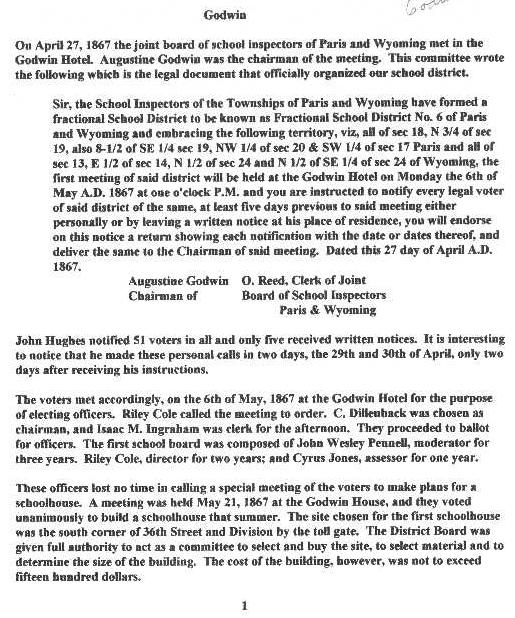
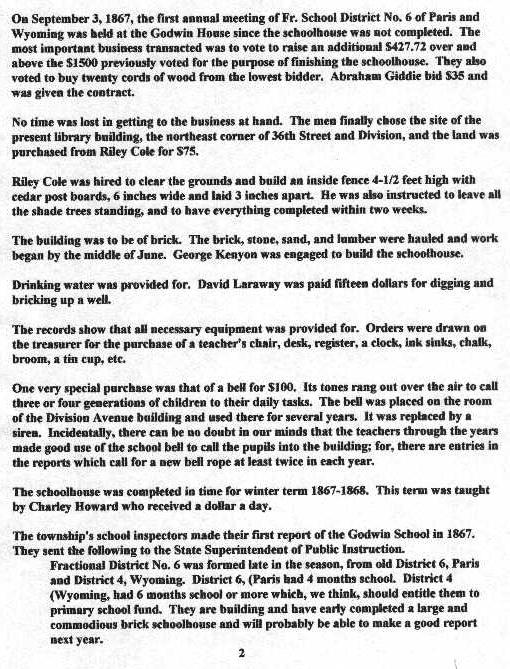
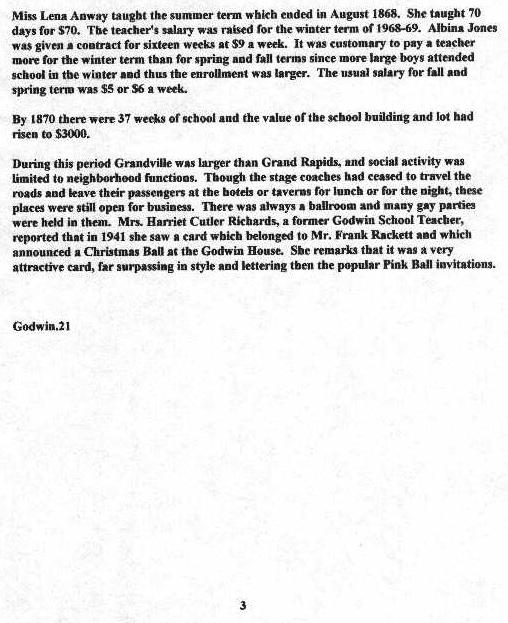


Left click on the images below for larger versions.

|

|

|
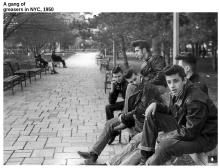
NYC - 1950 |
